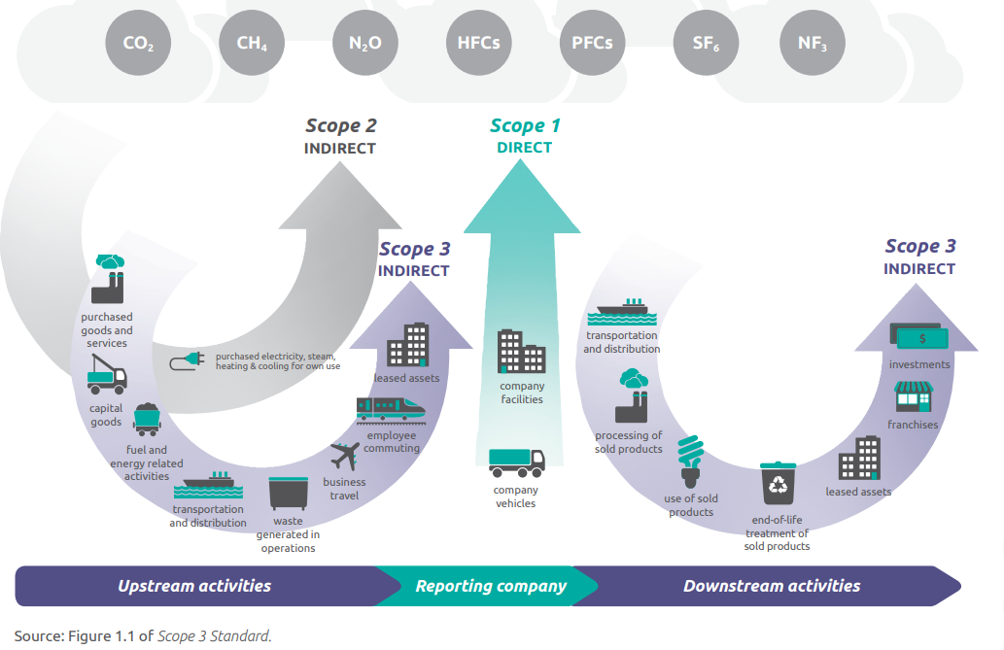Managing scope 3 (value chain) emissions

Companies naturally start considering their climate change impacts by looking at their own activities and facilities. However, indirect emissions from the wider value chain are often far greater. As the transition to ‘net zero’ gathers pace, the need to assess and manage these emissions sources is becoming more important. This article describes the best way manage your scope 3 emissions in five steps.
What are scope 3 emissions?
Scope 3 emissions are the indirect emissions arising from activities both upstream and downstream of an organisation. These are excluded from the Greenhouse Gas Protocol’s defined scope 1 and 2 reporting boundary, as shown in the GHG Protocol diagram (Figure 1 below).
Figure 1: Greenhouse gas (GHG) gases and categories of GHG emissions (1).

Scope 3 emissions typically account for a larger share of emissions than scope 1 and 2, unless the company has control of the product or service for much of its life cycle i.e. its supply chain is highly ‘vertically integrated’. For example, scope 3 emissions for a commercial landlord might be expected to be ten times that of its scope 1 and 2 emissions, as most of the GHG impact is due to the energy use of tenants. In manufacturing, the scope 3 emissions are likely to be perhaps two or three times greater that scope 1 and 2 as there are more energy intensive in-house activities, such as material processing and transport.
5 steps to managing scope 3 emissions
Given the wide range of sources, calculating scope 3 emissions can appear daunting. We have set out the five steps that can be taken to manage scope 3 emissions.

1. Focus on the most important areas.
The first step is to undertake a materiality assessment to focus efforts on the most important areas from the start, for example the largest likely sources, those over which the company has greatest influence and those of particular importance to stakeholders.
2. Use protocol guidance to produce an emissions assessment.
The next step is to produce a more detailed and quantified emissions assessment following the GHG Protocol scope 3 guidance. This may lead to the materiality assessment being updated, as initial assumptions are replaced with more rigorous analysis.
3. Look at the reduction options.
Companies should then consider the range of emission reduction pathways to manage and reduce scope 3 emissions. Scenario analysis is particularly useful, considering the ‘business as usual’ projection(s) and mapping this against areas of potential action. Previous site audit work can help inform this step (for example ESOS audits in the UK), but it may be necessary to undertake specific studies for assets or business activities to identify long term pathways for deep decarbonisation, rather than the short payback energy efficiency projects targeted by typical energy audits.
4. Set targets in line with SBTi
Typically, companies then choose to set targets to drive emission reduction. An increasing number of companies are choosing to have their targets approved by the Science-based Targets Initiative, which ensures that targets are in line the Paris 2 or 1.5 degree pathways (2). Sub targets may be developed to drive progress in difference divisions or geographies.
5. Robust reporting
Reporting will normally be required for both internal management and for external stakeholders. Requirements need to be considered carefully to maximise business benefit, and to allow for the impact of reduction initiatives to be captured. Some sources of Scope 3 emissions – such as embodied emissions from capital goods such as premises or large equipment – can be ‘lumpy’ and change considerably from year to year. A robust and consistent set of monitoring and reporting rules needs to be in place to manage this.
Further information on scope 3 emissions and target setting:
Watch our recent webinar:
Webinar: The challenge of setting value chain targets
Book a free consultation: to review your approach to managing scope 3 emissions and how Verco may assist you in your company’s journey to net zero.
Book a free 30 minute consultation
